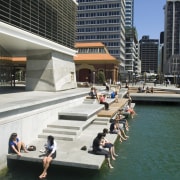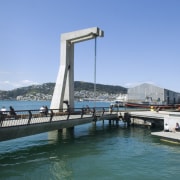Pedestrian flow
Kumutoto Public Space Development has turned Wellington's once neglected wharf areas into thriving hubs of pedestrian activity

You can almost hear the town planner's voice declaiming across the boardroom table: "This project is about giving the waterfront back to Wellingtonians." No matter how the concept was first aired, Wellington Waterfront Limited was there from the outset when the redevelopment of the waterfront was conceived. What had been a stretch of empty docklands was soon to become a commercial and recreational hub for the city.
Wellington Waterfront Limited, a company owned by the Wellington City Council, is charged with the on-going development and day-to-day management of the waterfront. Part of this role includes project managing the development of the Kumutoto area of the waterfront, says community relations manager Perry Walker.
"The master plan for this area, which provides for the development of four new buildings, including the new Meridian building, also adroitly considers the public spaces around buildings and the connections between them and other areas of the waterfront," says Walker. "The Kumutoto precinct has been named after a stream, piped underground for years, that now enters the harbour from a culvert adjacent to the Meridian building."

The design of the public space within this area provides three distinct open public spaces Kumutoto Plaza, the Wharf Plaza and Brandon Plaza all connected to each other and the Queens Wharf area further along the waterfront by a laneway running through the precinct and by the waterside promenade.
"Each area has a mix of trees, low-level planting, asphalt, concrete paving, granite cobbles, timber inlays and plenty of seating," says Walker. "They are attractive spaces that were immediately embraced by the public to eat their lunch, meet with friends, or read a book."
Five new pedestrian crossings across Customhouse Quay facilitate easy pedestrian movement between city and waterside.

"We want to bring people into the area and support safe, 24-hour use of the waterfront. A high-tech lighting design combines an intimate level of illumination with the optimum requirements for security, so the area can be used safely at all times," says Walker. "As well as linking Kumutoto with the CBD, we also need to ensure the new buildings are connected to their surroundings."
The Meridian building engages with its surrounding open spaces through a ground-floor retail fringe housing Mojo Coffee, Wagamama, Eon Design and the ticketing office for local ferry service East by West Ferries.
For details, contact Wellington Waterfronts Limited, PO Box 395, Wellington, phone (04) 495 7820. Email: info@wellingtonwatefront.co.nz, or visit the website: www.wellingtonwaterfront.co.nz.
Story by: Trendsideas
Home kitchen bathroom commercial design
Diving into nature
Personality plus
Classic looks, contemporary efficiency
Commercial Design Trends Vol. 24/4
This edition of Commercial Design Trends celebrates knowledge with an array of educational and research facilities that ...
Read More



